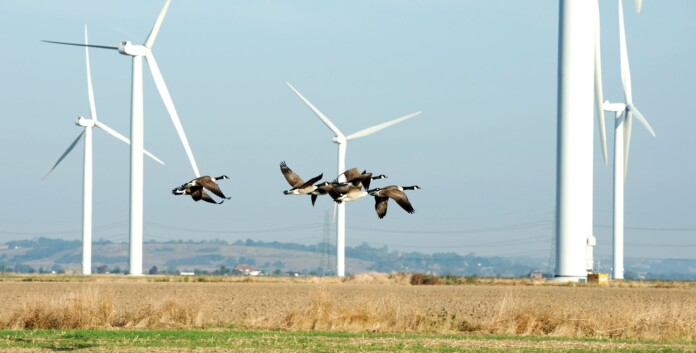Addressing the Challenge
As of March 2024, India had an installed wind power capacity of 45,586 MW, according to WindInsider.com. Given that the typical average capacity of a wind turbine is around 2 MW, this suggests that India has approximately 23,000 wind turbines. However, official data on the precise number of wind turbines is not available.
Windergy India 2024: Accelerating India’s Clean Energy Transition – WindInsider
The large-scale deployment of wind turbines, particularly in states like Gujarat and Tamil Nadu, plays a crucial role in India’s renewable energy generation. However, concerns about bird mortality from turbine collisions have emerged, especially considering the vital role birds play in agriculture. Birds contribute to pest control, pollination, and seed dispersal. For example, a single barn owl can consume 1,000–1,500 rodents annually, reducing crop damage. Each bird species brings unique benefits to agricultural ecosystems.
India is home to around 1,353 bird species, making it one of the most bird-diverse countries. However, the State of India’s Birds 2023 report highlights that 60% of bird species have experienced long-term declines, driven by deforestation, urbanization, pollution, and climate change. This includes significant losses among grassland birds, waterbirds, and migratory species. Studies from institutions like the Salim Ali Centre for Ornithology and Natural History, the Karnataka Forest Department, and the Bombay Natural History Society have examined the impact of wind turbines on avian populations.
Research from the Norwegian Institute for Nature Research suggests a simple mitigation measure: painting one turbine blade black, which improves visibility for birds and reduces collisions by up to 72%, providing a promising solution for protecting India’s bird populations, which are critical to agricultural productivity.
This simple fix will make wind turbines more bird-friendly | Electrek
Other Studies on Wind Turbines
Efforts to make wind turbines safer for birds extend beyond the work of the Norwegian Institute for Nature Research (NINA). Various approaches, such as smart curtailment systems that temporarily stop turbines when bird activity is detected, and radar or acoustic deterrents that warn birds away from turbines, have been explored. Organizations like the American Wind Wildlife Institute (AWWI) are pioneering these strategies. While effective, NINA’s blade-painting solution remains one of the most cost-effective and easily implementable options.
A Call to Action – Immediate
Mandate for Manufacturers:
India should require all wind turbine manufacturers to paint one blade black. This aligns with corporate social responsibility (CSR) and environmental, social, and governance (ESG) goals. Additionally, the government could provide incentives like tax breaks to encourage swift adoption. Future turbine designs should also prioritize recyclable blades, as advancements in this area continue.
Collaborative Research:
Indian research institutions, particularly in wind-rich states like Gujarat and Tamil Nadu, should collaborate with international experts such as the Norwegian Institute for Nature Research (NINA). Expanding studies to include more bird species and larger geographic areas would help ensure that solutions are effective across India’s diverse ecosystems. India can also learn from international partnerships, such as Oregon State University’s collaboration with Pacific Corp Wind Farms in the U.S., where painting one turbine blade black on 36 turbines is being tested to reduce bird strikes. The goal of this collaborative research is to obtain more accurate data on bird and bat mortality using a larger sample size than NINA’s studies.
Additionally, India’s long-standing partnership with the International Union for Conservation of Nature (IUCN) on biodiversity projects could be leveraged to refine strategies that balance wind energy development with wildlife conservation efforts.
Blade-less Turbines:
India should explore advancements in bladeless wind turbine technology, which promises to be more cost-effective, compact, and safer for wildlife. Companies like Vortex Blade-less Turbines are working on solutions suited for urban areas with lower wind speeds, and further investment in these technologies could make India a leader in future-proof renewable energy. The government could incentivize homeowners and residential complexes to install bladeless turbines by offering zero-GST on these products.
A Call To Action – Future
Global Leadership Opportunity
By swiftly adopting these measures, India can position itself as a global leader in both renewable energy and biodiversity conservation. Presenting these efforts at international platforms like COP conferences would demonstrate India’s commitment to sustainability and innovation in wind energy.
Nature Aligned Initiatives
Any product design should prioritize benefiting nature and minimizing harm to biodiversity and the environment. For example, bats are particularly vulnerable to barotrauma—lung damage caused by the rapid pressure changes near wind turbine blades. One speculative option for future wind farms is installing bladed or blade-less turbines on decommissioned ships. If bladed turbines are placed at slightly lower levels, bird mortality could be reduced, as many seabirds tend to fly higher, and there are generally fewer bird species in ocean environments compared to land. Additionally these ships could serve other purposes such as public storage, vocational training schools, labs that can grow a variety of sustainable products and so on.
Conclusion
India stands at a crucial juncture in its renewable energy journey. By implementing straightforward solutions like painting turbine blades and exploring innovative technologies, the country can safeguard bird populations, enhance agricultural productivity, and reinforce its leadership in sustainability. Prioritizing decentralized approaches, such as adopting bird-friendly, blade-less wind turbines for residential use, presents a more sustainable alternative to large, non-recyclable turbines. Additionally, a thorough evaluation of offshore versus onshore wind farming is essential. India also requires a comprehensive wind energy strategy that balances bird conservation, agricultural needs, efficient land use, and the principles of a circular economy. Now is the time for India to take decisive action and set a global example in responsible wind energy development.
Ram Ramprasad is a passionate advocate for sustainability. He has written many articles on sustainable strategies for well-known publications. Ram has also served as the Global Marketing Director for a leading multinational company in the USA. He holds degrees from Madras University in India and Yale University in the USA.










